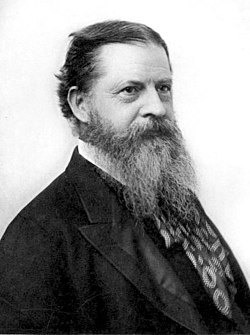Logical NOR
| NOR | |
|---|---|
 | |
| Definition | |
| Truth table | |
| Logic gate | |
| Normal forms | |
| Disjunctive | |
| Conjunctive | |
| Zhegalkin polynomial | |
| Post's lattices | |
| 0-preserving | no |
| 1-preserving | no |
| Monotone | no |
| Affine | no |
| Self-dual | no |
| Logical connectives | ||||||||||||||||||||||||||
|---|---|---|---|---|---|---|---|---|---|---|---|---|---|---|---|---|---|---|---|---|---|---|---|---|---|---|
|
||||||||||||||||||||||||||
| Related concepts | ||||||||||||||||||||||||||
| Applications | ||||||||||||||||||||||||||
|
| ||||||||||||||||||||||||||
| Part of a series on |
| Charles Sanders Peirce |
|---|
 |
| Pragmatism in epistemology |
| Logic |
|
| Semiotic theory |
| Miscellaneous contributions |
| Biographical |
In
Non-disjunction is usually denoted as or or (prefix) or .
As with its
The computer used in the spacecraft that first carried humans to the moon, the Apollo Guidance Computer, was constructed entirely using NOR gates with three inputs.[2]
Definition
The NOR operation is a
Truth table
The truth table of is as follows:
| F | F | T |
| F | T | F |
| T | F | F |
| T | T | F |
Logical equivalences
The logical NOR is the negation of the disjunction:
| |
Alternative notations and names
Peirce is the first to show the functional completeness of non-disjunction while he doesn't publish his result.[3][4] Peirce used for non-conjunction and for non-disjunction (in fact, what Peirce himself used is and he didn't introduce while Peirce's editors made such disambiguated use).[4] Peirce called the ampheck (from Ancient Greek ἀμφήκης, amphēkēs, "cutting both ways").[4]
In 1911, Stamm was the first to publish a description of both non-conjunction (using , the Stamm hook), and non-disjunction (using , the Stamm star), and showed their functional completeness.[5][6] Note that most uses in logical notation of use this for negation.
In 1913,
In 1935, Webb described non-disjunction for -valued logic, and use for the operator. So some people call it Webb operator,[7] Webb operation[8] or Webb function.[9]
In 1940, Quine also described non-disjunction and use for the operator.[10] So some people call the operator Peirce arrow or Quine dagger.
In 1944, Church also described non-disjunction and use for the operator.[11]
In 1954, Bocheński used in for non-disjunction in Polish notation.[12]
APL uses a glyph ⍱ that combines a ∨ with a ~.[13]
Properties
NOR is commutative but not associative, which means that but .[14]
Functional completeness
The logical NOR, taken by itself, is a functionally complete set of connectives.[15] This can be proved by first showing, with a truth table, that is truth-functionally equivalent to .[16] Then, since is truth-functionally equivalent to ,[16] and is equivalent to ,[16] the logical NOR suffices to define the set of connectives ,
This may also be seen from the fact that Logical NOR does not possess any of the five qualities (truth-preserving, false-preserving,
Other Boolean operations in terms of the logical NOR
NOR has the interesting feature that all other logical operators can be expressed by interlaced NOR operations. The
Expressed in terms of NOR , the usual operators of propositional logic are:
|
| |||||||||||||||||||||
|
|
|
See also
- Bitwise NOR
- Boolean algebra
- Boolean domain
- Boolean function
- Functional completeness
- NOR gate
- Propositional logic
- Sole sufficient operator
- Sheffer stroke as symbol for the logical NAND
References
- ^ ISBN 978-0-415-13342-5.
- ISBN 1-56347-185-X.
- ^ Peirce, C. S. (1933) [1880]. "A Boolian Algebra with One Constant". In Hartshorne, C.; Weiss, P. (eds.). Collected Papers of Charles Sanders Peirce, Volume IV The Simplest Mathematics. Massachusetts: Harvard University Press. pp. 13–18.
- ^ a b c Peirce, C. S. (1933) [1902]. "The Simplest Mathematics". In Hartshorne, C.; Weiss, P. (eds.). Collected Papers of Charles Sanders Peirce, Volume IV The Simplest Mathematics. Massachusetts: Harvard University Press. pp. 189–262.
- S2CID 119816758.
- ^ Zach, R. (2023-02-18). "Sheffer stroke before Sheffer: Edward Stamm". Retrieved 2023-07-02.
- PMID 16577665.
- LCCN 2011929655. p. 20:
Historical background […] Logical operator NOR named Peirce arrow and also known as Webb-operation.
(xiii+1+123+7 pages) (NB. The back cover of this book erroneously states volume 4, whereas it actually is volume 101.) - ^ Freimann, Michael; Renfro, Dave L.; Webb, Norman (2018-05-24) [2017-02-10]. "Who is Donald L. Webb?". History of Science and Mathematics. Stack Exchange. Archived from the original on 2023-05-18. Retrieved 2023-05-18.
- ^ Quine, W. V (1981) [1940]. Mathematical Logic (Revised ed.). Cambridge, London, New York, New Rochelle, Melbourne and Sydney: Harvard University Press. p. 45.
- ^ Church, A. (1996) [1944]. Introduction to Mathematical Logic. New Jersey: Princeton University Press. p. 37.
- ^ Bocheński, J. M. (1954). Précis de logique mathématique (in French). Netherlands: F. G. Kroonder, Bussum, Pays-Bas. p. 11.
- ^ Nor, APL Wiki.
- ISBN 978-81-88237-49-4.
- ISBN 978-0-486-68370-6.
- ^ ISBN 978-0-415-13342-5.
External links
 Media related to Logical NOR at Wikimedia Commons
Media related to Logical NOR at Wikimedia Commons





































































